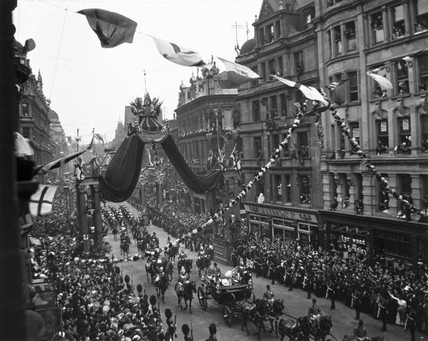- Home
- Local History
- The Coronation
The Coronation
Written by PAM PREEDY, historian & author.
There have been 39 coronation ceremonies for monarchs held in England. The first can be traced to the ceremony devised by Saint Dunstan for King Edgar’s crowning at Bath Abbey in 973AD (CE). The earliest form of an oath was an oral contract between a monarch and their people. The crown may have been an ornate helmet.
At this time there was no immediate (or automatic) right of succession, and so a coronation was an essential rite of passage.
Nowadays, a sovereign succeeds, by law, immediately upon the death of another, although the ceremony remains an important event early in a new reign. When William the Conqueror (1066-1087) was crowned on Christmas Day 1066, he began the tradition of holding a lavish coronation ceremony at Westminster Abbey.
The coronation emerged from a European tradition of increasing church involvement in the state, as well as the need to bring stability to often unstable societies in which several individuals had a claim to the throne. Central to the ceremony is the ‘unction’, the act of anointing a monarch with holy oil. It can be dated back to the 7th or 8th century. This signals the conferment of God’s grace upon the ruler.


(Wenceslaus Hollar, Wikimedia Commons)

(Author unknown, Wikimedia Commons)
Continuing the tradition
Today, the United Kingdom is the only European monarchy to retain such a ceremony. As we all know, the last one was for Queen Elizabeth II on 2nd June 1953 and the next one will be on 6th May 2023 for King Charles III. Every ceremony is different and organised and paid for by the state, with input from the new monarch. The coronation of Charles III has evolved from the coronation of King Edward VII.
When ceremonies go wrong...
- When the Archbishop of Canterbury tried to put the ring on the finger of Queen Victoria, he tried to ram it on her fourth finger, but it had been sized for the little pinky. After the ceremony, she had to soak her hand in iced water to get the ring off.
- Sometimes the crown jewels had been lost or went missing. During the English Civil War, the crown jewels were pawned by the Royalists to pay for their part of the military conflict. After the war Oliver Cromwell melted down some of the jewels for his own use and Charles II had to commission new jewels for his coronation.
- At nine years old, Henry III was crowned at Glastonbury Abbey in 1220 with one of his mother’s circlets because his father, King John, had lost the crown jewels when his baggage train overturned in a bog. Four years later, with new crown jewels, Henry had a second proper coronation in Westminister Abbey.
- George IV was married to Queen Caroline, whom he did not like. He did not want her at his coronation and she was determined to attend. She was left outside banging on the abbey doors, but the guards would not let her in and she was turned away.

(Charles Edward Wagstaff, via Wikimedia Commons)
Originally published in Life in Bromley magazine (Issue 15, May 2023)
Images sourced via Wikimedia Commons
